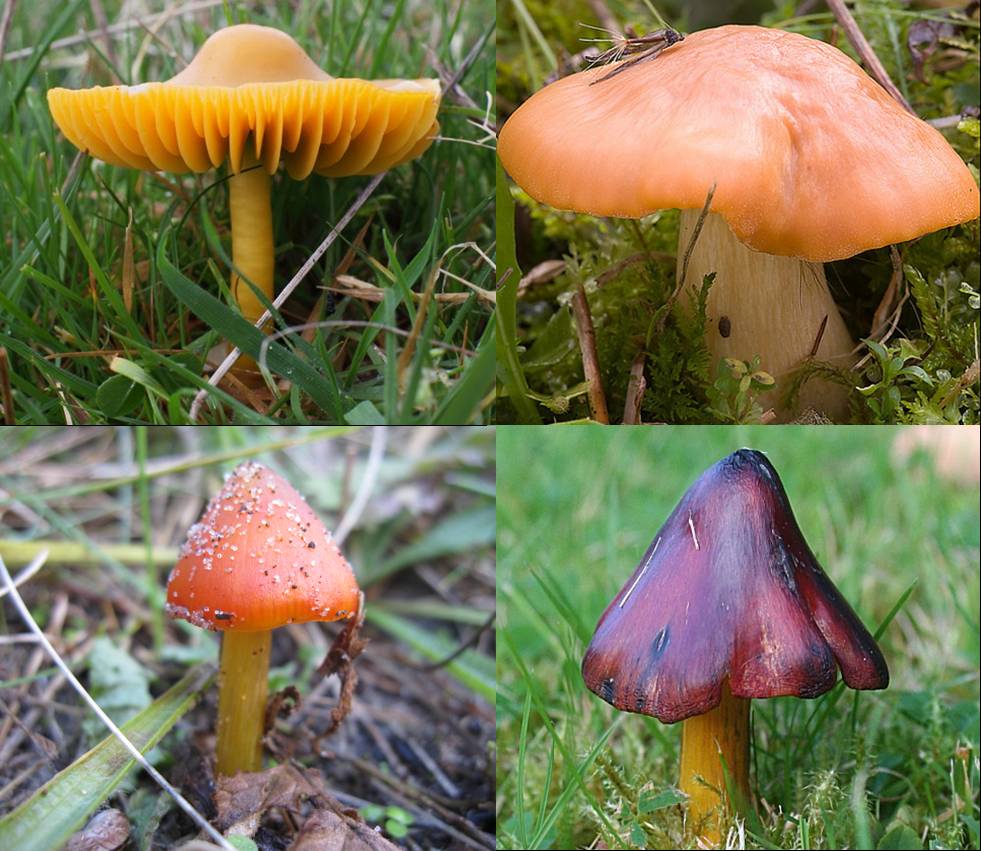Biodiversity
Related Links
Latest News
A Starring Role for Nantclwyd’s Lesser Horseshoe Bats
22.05.2015
Living Landscape Brought Back to Life
05.12.2014
More Information
Use the links above to explore the conservation of waxcaps and their habitat.
Facebook Page
Waxcap fungi
For all grassland fungi, the mushrooms or toadstools we see above ground (the fruiting bodies), are only a small fraction of the whole fungus. In the soil are large networks of fine, root-like ‘mycelia’ which comprise the bulk of the organism.
Description and identification: The visible parts of waxcap fungi, the fruiting bodies, are brightly coloured, ranging from yellows, oranges and reds, to purples and even black. Under the cap are thick often waxy gills and some species are slimy because of a glutinous surface layer. With over 40 different species of waxcap in the UK, identifying individual species takes practice – try this online key from Aberystwyth University.
 Habitat: Almost all species of waxcap in Britain inhabit grasslands, such as unimproved pasture, hay meadows, old lawns and churchyards. These are known as ‘waxcap grasslands’. Waxcaps require nutrient-poor soils, so the habitat must not have had fertilizer applied recently. Grazing or mowing is necessary to maintain short turf, which promotes fruiting. Waxcaps can also be found in heaths, mires and coastal habitats such as sand dunes.
Habitat: Almost all species of waxcap in Britain inhabit grasslands, such as unimproved pasture, hay meadows, old lawns and churchyards. These are known as ‘waxcap grasslands’. Waxcaps require nutrient-poor soils, so the habitat must not have had fertilizer applied recently. Grazing or mowing is necessary to maintain short turf, which promotes fruiting. Waxcaps can also be found in heaths, mires and coastal habitats such as sand dunes.
Ecology and reproduction: Waxcaps play a vital role in ensuring the functioning of grassland ecosystems, by breaking down organic matter in the soil. Underground, enzymes are secreted which dissolve plant debris in the soil, releasing nutrients which are then absorbed by the fungus. The fruiting bodies are required for reproduction and produce spores inside the cap, which when released, are transported by the wind away from the parent.
Distribution: Waxcaps are distributed worldwide. In Europe they are more common in wetter western and northern areas. In Denbighshire some good sites to see waxcaps include Dinas Brân in Llangollen, Bodelwyddan Castle Estate and the North Wales Wildlife Trust reserve at Aberduna, near Maeshafn.
Threats: The biggest threat facing waxcaps is habitat loss, through inappropriate development and agricultural intensification. They are also sensitive to changes in their habitat, such as fluctuations in soil moisture and temperature, which can reduce the production of fruiting bodies. Ploughing is also detrimental because it breaks up the mycelia in the soil, which can take decades to recover. Waxcaps, and fungi more generally, have been under-recorded and their importance has been overlooked. It is interesting that grasslands with the greatest number and diversity of waxcaps are often not that rich in flowering plants – so conserving species-rich grasslands won’t necessarily protect waxcaps.
Status: Only one species, the date-coloured waxcap, is listed as a priority species for conservation at a UK and Wales level, but it has not been recorded in Denbighshire. Waxcaps are a priority for conservation at a Denbighshire level.



